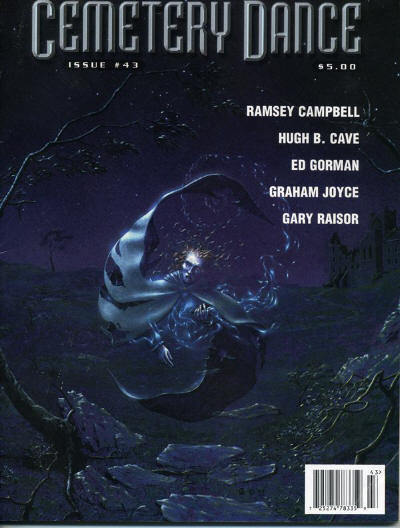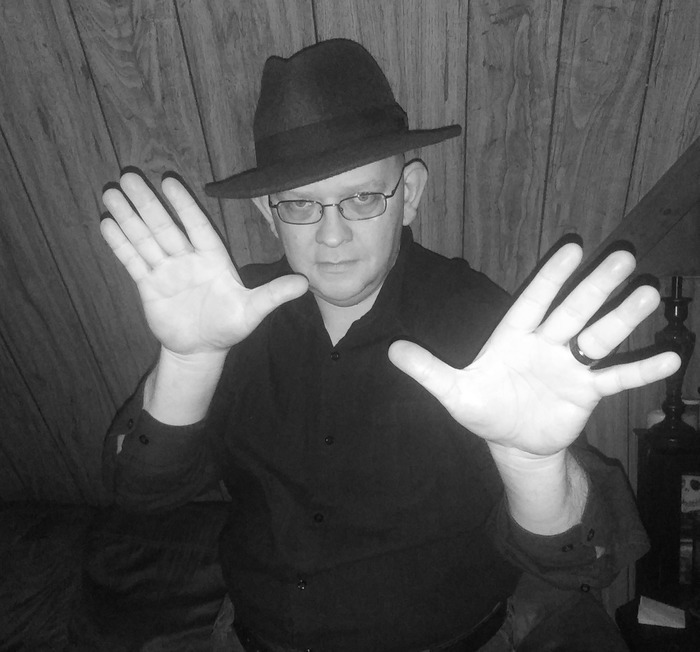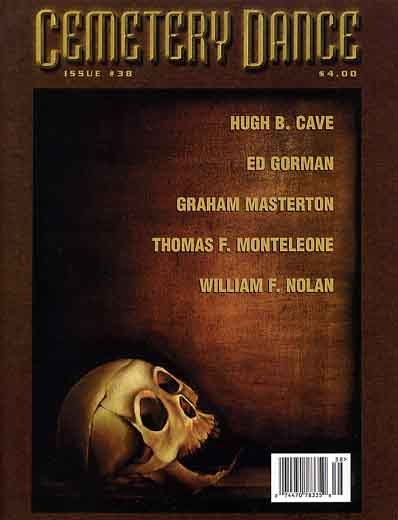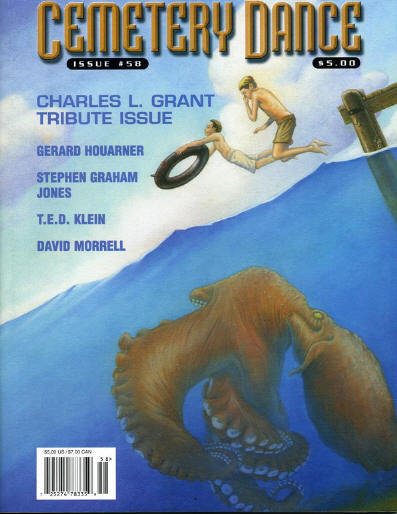
Part of Series
3 • Words from the Editors (Cemetery Dance #43) • [Editorial (Cemetery Dance)] • essay by Robert Morrish 3 • Words from the Editors (Cemetery Dance #43) • [Editorial (Cemetery Dance)] • essay by Richard Chizmar 4 • A Conversation with Ramsey Campbell • interview of Ramsey Campbell • interview by William P. Simmons 11 • Met a Pilgrim Shadow • short story by Tim Waggoner 16 • From the Dead Zone: Stephen King News (Cemetery Dance #43) • [From the Dead Zone] • essay by Bev Vincent 27 • The Loneliest Night of the Week • short story by Ed Gorman 32 • The Mothers and Fathers Italian Association (Cemetery Dance #43) • [The Mothers and Fathers Italian Association] • essay by Thomas F. Monteleone 39 • Yesterday, Upon the Stair • short story by Tony Richards 44 • Waves of Fear (Cemetery Dance #43) • essay by Paula Guran 51 • Darkness Closing • short story by Greg Kishbaugh 56 • A Conversation with Graham Joyce • interview of Graham Joyce • interview by Darrell Schweitzer 62 • MediaDrome (Cemetery Dance #43) • [MediaDrome] • essay by Michael Marano 69 • Clarissa • short story by Hugh B. Cave 76 • The Day Before Yesterday (Cemetery Dance #43) • essay by Ed Gorman 79 • Willpower • short story by Gary L. Raisor [as by Gary Raisor] 88 • A Conversation with Al Magliochetti • interview of Al Magliochetti • interview by Eve Blaack 94 • CD Reviews (Cemetery Dance #43) • essay by various
Authors



'Simmons draws from a well with waters dark and deep, that taste of guilt, despair and fear, to cultivate his surprising and inventive tales of horror.' — ADAM NEVILL (British Fantasy Award Winning author of THE RITUAL and NO ONE GETS OUT ALIVE). William Simmons is an acclaimed author, critic, anthologist, and journalist specializing in supernatural horror fiction. He is an Active Member of the HWA. Eight of his stories received ‘Honorable Mentions’ in The Year’s Best Fantasy & Horror. His collection WE FEED THE DARK received accolades from such horror legends as ADAM NEVILL, ERIC J. GUINGARD, and FORREST AGUIRRE. “Avoiding horror’s traditional icons and their premeasured fright potential ... (Simmons is) a writer whose approach is both original and refreshingly unconventional.”
- PUBLISHER'S WEEKLY His collection BY REASON OF DARKNESS received rave reviews from Cemetery Dance, All Hallows, and Publisher's Weekly, who called him Simmons “…evokes both Ray Bradbury and Joyce Carol Oates.” – PETER BELL, All Hallows His first collection BECOMING OCTOBER sold out quickly upon release, and he collaborated on the Halloween collection DARK HARVEST with author Paul Melznick. His stories have appeared in several venues, including Cemetery Dance, Flesh & Blood, Darkness Rising (1-9), Infinity Plus, Dark Discoveries, and many more. His poetry has appeared in Chizine, Gothic.net, Lullaby Hearse, Dead Cat Bouncing, etc. GRAHAM MASTERTON, author of The Minatou, said Simmons “has the gift of making an ordinary day seem scary.” NANCY KILPATRICK, author of The Goth Bible, said “Simmons has a knack for constructing dark, creepy, introverted tales, full of obscure terrors that reflect nearly mythical realms.” And T.M. WRIGHT, author of Strange Seed, compared Simmons’ horror fiction to “like being taken back forty years and discovering Poe for the first time, and M.R. James, and Shirley Jackson.” Simmons has contributed reviews, essays, and scholarship to Rue Morgue, Publisher’s Weekly, Wormwood, Hellnotes, Gauntlet, Cemetery Dance, and others. His review columns include “Dark Devotions”, “Literary Lesions”, and “Folk Fears”. He contributed an introduction to Falling into Heaven, by Maynard & Sims, and his reviews have been blurbed for several books. As a journalist, he created Our Ladies of Darkness, one of the earlier interview columns devoted to female genre authors, and Beyond the Fifth Dimension: The Twilight Zone Interviews, which spoke with surviving scribes of the influential television series. He also conducted two special chapbook length interviews with Richard Matheson and F. Paul Wilson, both for Gauntlet Press. His reviews have been used as blurbs by Tartan Asian Extreme and he has contributed Liner Notes to DVD releases. “His anthologies are carefully crafted, the stories bleeding into each other with seamless precision.” – MAYNARD & SIMS, Demon Eyes. As an anthologist he has edited the bestselling SEASON OF THE DEAD: SUPERNATURAL HORROR FOR HALLOWEEN (reviewed by Rue Morgue) and the bestselling WILDWOOD: TALES OF TERROR & TRANSFORMATION FROM THE FOREST. His other anthologies are MONSTER CARNIVAL and YULETIDE FRIGHTS. He is the series editor for Shadow House Publishing has several anthologies and single author collections in development. for Shadow House Publishing, including The Library of Weird Fiction and Horror Hall of Fame Novellas.


Graham Joyce (22 October 1954 – 9 September 2014) was an English writer of speculative fiction and the recipient of numerous awards for both his novels and short stories. After receiving a B.Ed. from Bishop Lonsdale College in 1977 and a M.A. from the University of Leicester in 1980. Joyce worked as a youth officer for the National Association of Youth Clubs until 1988. He subsequently quit his position and moved to the Greek islands of Lesbos and Crete to write his first novel, Dreamside. After selling Dreamside to Pan Books in 1991, Joyce moved back to England to pursue a career as a full-time writer. Graham Joyce resided in Leicester with his wife, Suzanne Johnsen, and their two children, Joseph and Ella. He taught Creative Writing to graduate students at Nottingham Trent University from 1996 until his death, and was made a Reader in Creative Writing. Joyce died on 9 September 2014. He had been diagnosed with lymphoma in 2013.

Hugh Barnett Cave was a prolific writer of pulp fiction who also excelled in other genres. Sources differ as to when Cave sold his first story: some say it was while he still attended Brookline High School, others cite "Island Ordeal", written at age 19 in 1929 while still working for the vanity press. In his early career he contributed to such pulp magazines as Astounding, Black Mask, and Weird Tales. By his own estimate, in the 1930s alone, he published roughly 800 short stories in nearly 100 periodicals under a number of pseudonyms. Of particular interest during this time was his series featuring an independent gentleman of courageous action and questionable morals called simply The Eel. These adventures appeared in the late 1930s and early 40s under the pen name Justin Case. Cave was also one of the most successful contributors to the weird menace or "shudder pulps" of the 1930s. In 1943, drawing on his experience as a war reporter, he authored one of his most highly regarded novels, Long Were the Nights, telling of the first PT boats at Guadalcanal. He also wrote a number of other books on the war in the Pacific during this period. During his post-war sojourn in Haiti, he became so familiar with the religion of Voodoo that he published Haiti: High Road to Adventure, a nonfiction work critically acclaimed as the "best report on voodoo in English." His Caribbean experiences led to his best-selling Voodoo-themed novel, The Cross On The Drum (1959), an interracial story in which a white Christian missionary falls in love with a black Voodoo priest's sister. During this midpoint in his career Cave advanced his writing to the "slick" magazines, including Collier's, Family Circle, Ladies' Home Journal, Redbook, and the Saturday Evening Post. It was in this latter publication, in 1959, that "The Mission," his most popular short story, appeared—subsequently issued in hardcover by Doubleday, reprinted in textbooks, and translated into a number of languages. But his career took a dip in the early 1970s. According to The Guardian, with the golden era of pulp fiction now in the past, Cave's "only regular market was writing romance for women's magazines." He was rediscovered, however, by Karl Edward Wagner, who published Murgunstrumm and Others, a horror story collection that won Cave the 1978 World Fantasy Award. Other collections followed and Cave also published new horror fiction. His later career included the publication in the late 1970s and early 1980s of four successful fantasy novels: Legion of the Dead (1979), The Nebulon Horror (1980), The Evil (1981), and Shades of Evil (1982). Two other notable late works are Lucifer's Eye (1991) and The Mountains of Madness (2004). Moreover, Cave took naturally to the Internet, championing the e-book to such an extent that electronic versions of his stories can readily be purchased online. Over his entire career he wrote more than 1,000 short stories in nearly all genres (though he is best remembered for his horror and crime pieces), approximately forty novels, and a notable body of nonfiction. He received the Phoenix Award as well as lifetime achievement awards from the International Horror Guild, the Horror Writers Association, and the World Fantasy Convention. (From Wikipedia.) Used the pseudonyms John Starr and Justin Case

